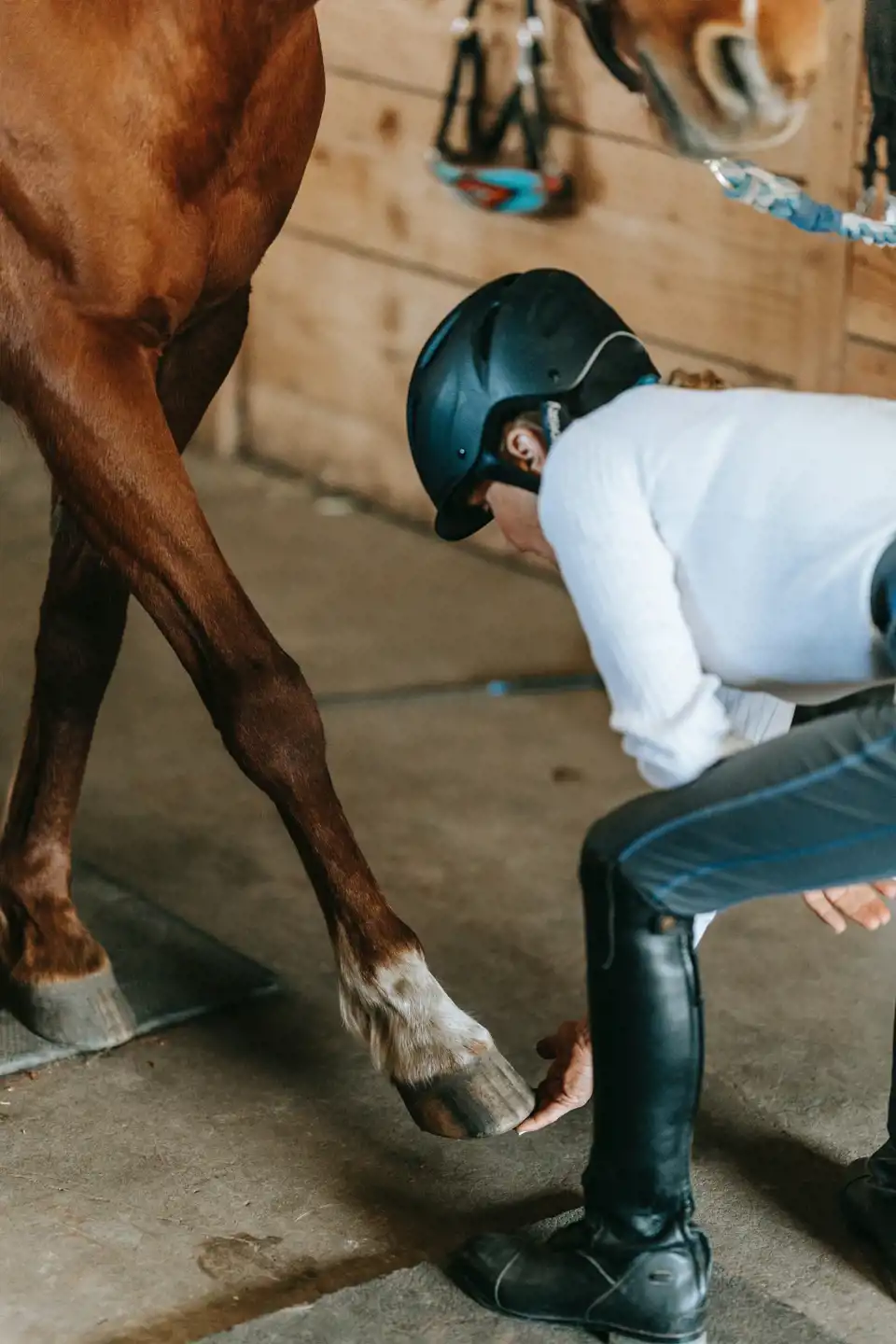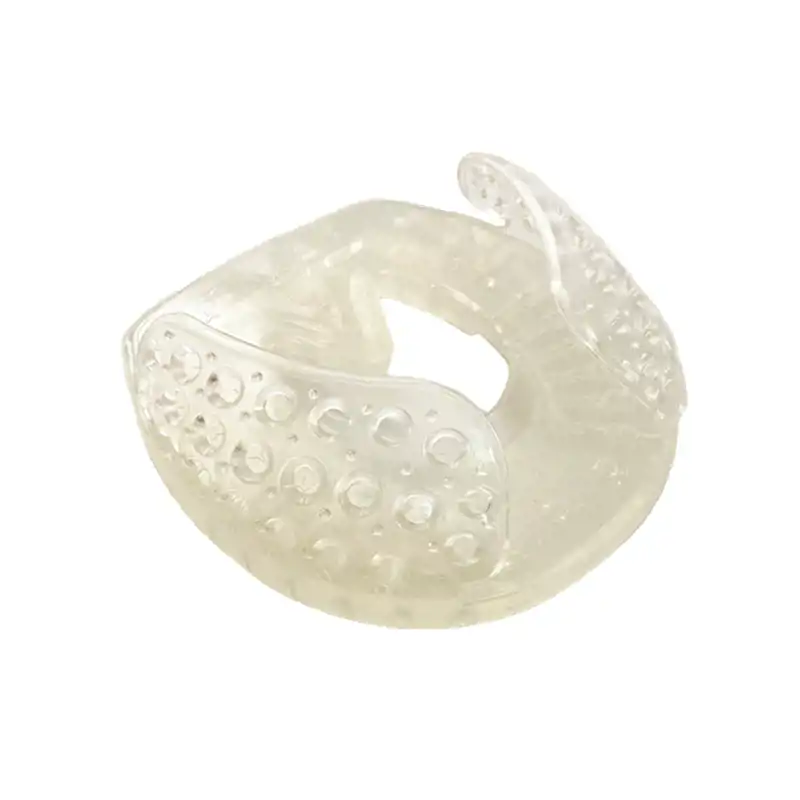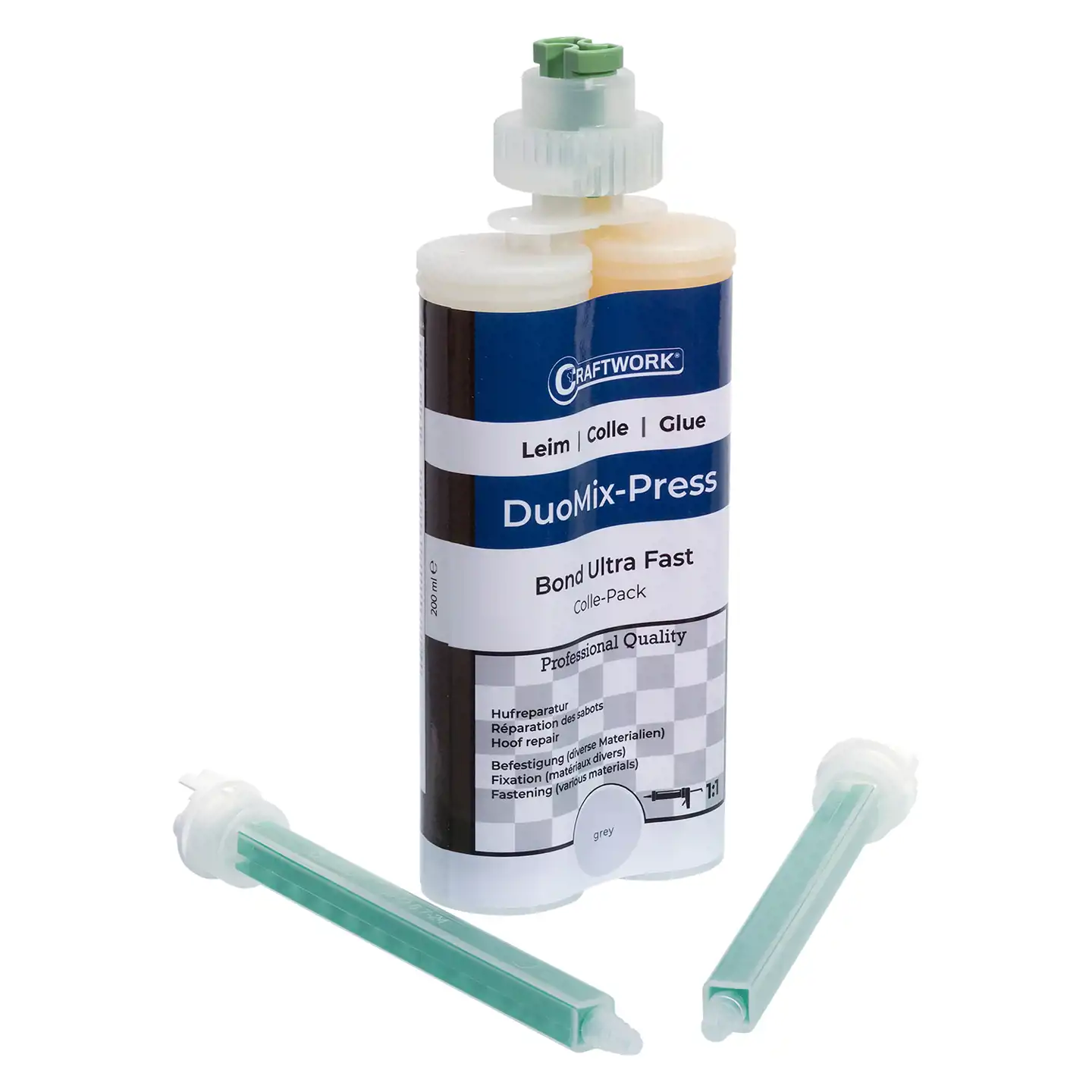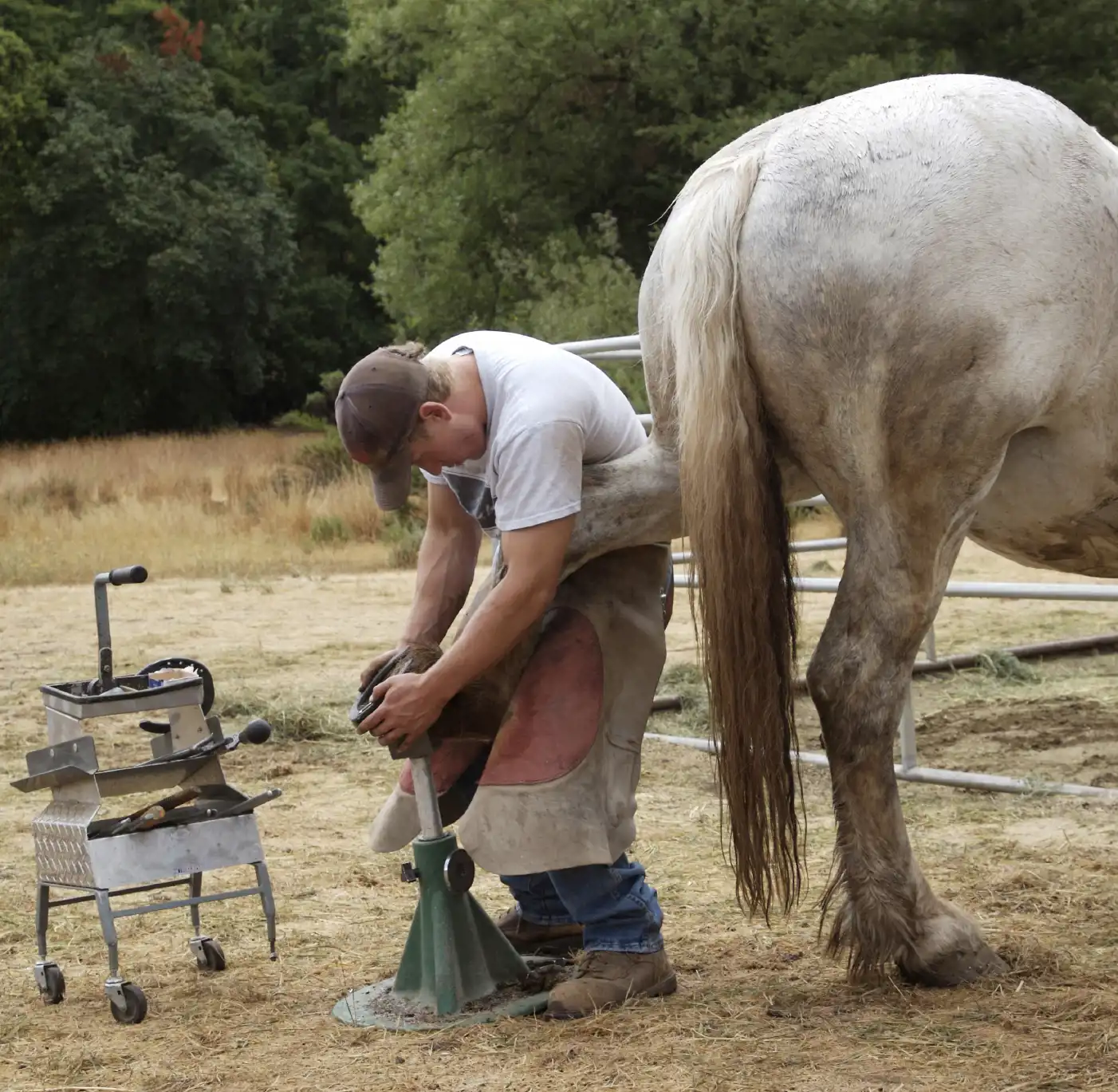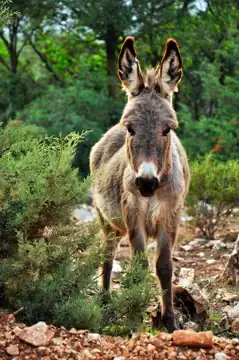Why is hoof care important?
Important with regular hoof care is that the horse is brought into balance by correct hoof positioning. Incorrect hoof positions have negative effects on the overall well-being of the horse. A horse or donkey tries to compensate for irregularities in the hooves. This can lead to incorrect stresses on the skeleton, up to and including arthrosis, joint inflammation, tendon and ligament problems, but also cramps (e.g. in the back), which can lead to lameness. Horses with horseshoes are usually shod every 6 to 8 weeks. For barefoot horses, care (rasping, shearing, etc.) must be ensured at least at the same interval (varies from individual to individual) so that the hoof does not become too long or crooked. Hooves grow 8 to 10 mm per month.
However, due to the horse's use and depending on the type of ground on which it moves, this can also be worn away quickly. Then the hoof is not too long, but may have become crooked due to growth.
The more exercise a horse or donkey has, the better the blood flow to the hoof and the more good horn grows back from the coronet band. A healthy bare hoof should be on a variety of soils, if possible, so that the hoof is used in a variety of ways and has enough wear.
For healthy hooves, check the length of the toe
- Too short toes: The sole leather skin in the front hoof area is bruised.
- Too long toes: Lengthen the lever arm when rolling, causing increased stress on the deep flexor tendon and navicular bone. The increased stress on the corium in the area of the front wall can cause bleeding, and in severe cases even laminitis.
Hoof care: The correct front and rear hoof
4 angles for assessment
- From the front: diameter at the coronet band is smaller than at the bearing band, the outer wall is slightly more angled, the inner and outer walls are the same height.
- From behind: The heels are neither too narrow nor too wide and of equal height. The outer wall of the heel is slightly more angled than the inner wall. The frog is distinctly developed and rests on the ground when the dog takes to the ground.
- From below: The front hoof is rounded, the hind hoof oval. The sole is slightly arched upwards, the frog well developed and dry, the corner struts straight and slightly angulated. The heels, respectively pads, are on a line perpendicular to the toe axis. The white line is even, without interruption.
- From the side: The toe axis is the straight extension of a line through the pastern, coronet and coffin bone and runs parallel to the toe wall. On the front hoof this forms an angle of 45-50° to the horizontal and on the hind hoof 50-55°. The heel walls run parallel to the toe wall.
Important postural and positional hoof problems
Contracted hoof
Hoof contraction is the atrophy and shrinkage of the soft tissue in the back half of the hoof (the caudal hoof), particularly the frog and digital cushion.
There are several approaches to treating the contracted hoof. Recently, attempts have been made to pursue a switch to bare hoof so that the constriction of the hoof is reduced again. Certain farriers report that they are using relatively "soft" glue-on shoes, such as Easycuff Glue-on, have also seen positive changes.
Symptoms: Little space between the outer and inner corners of the heel, narrowing of the horn capsule, impaired movement processes in the hoof, hesitant rolling (rear hoof area).
Causes: Inadequate hoof care, lack of exercise, incorrect position, thrush, navicular lameness, poor adaptation of horseshoes.
Horn pillars/keratomas
Keratomas/horn columns must be surgically removed by a veterinarian.
- Symptoms: Horn column as a change in the bearing edge. Asymptomatic to high grade when the horn column creates too much tension to the hoof corium.
- Causes: Horn columns are caused, for example, by injuries to the coronet band and/or inflammation of the hoof corium.
Cleft horn
Horn gaps can be stabilized by the farrier or veterinarian. To prevent the corium from becoming trapped in the cleft, a hoof clip or a hoof patch Hornspaltpflaster Dallmer can be used. Often, an attempt is also made to barefoot the horse for a period of time and use a hover to reduce the tension on the horn gap.
- Symptoms: Crack in the bearing rim. Asymptomatic to high grade when horn crack penetrates to hoof corium. Exposed hoof corium is crushed into cleft, bleeding and inflammation occur. Usually secondary infections of local tissues.
- Causes: Uneven loading conditions in the hoof due to shoeing and positioning errors. Favored by poor horn quality (wide hooves, dry horn, poor care).
- Other causes: Deep crown treads.
Thrush
Thrush can be treated with different means, whereby the hygiene in the whole must be considered, i.e. the microclimate in the stable and in the box must be improved. It is important that the affected hoof areas are well freed from the steel rot, for this purpose a clean and sharp hoof knife should be used, e.g. Hoof knife Razor R Scalpel.
For treatment, proven, albeit somewhat aggressive agents can be used, such as copper vitriol or copper sulfate granules. Alternatively, there are very low-viscosity products that penetrate very well into any crevices and cracks in the steel area, such as Carré TB Intensive Frog Care. Other products contain, for example, laurel oil or tea tree oil, these products are more viscous and remain a little longer on the treated area.
- Symptoms: Greasy, grayish-white, foul-smelling mass in the middle or lateral frog furrows. Horn is dissolved down to the corium.
- Causes:Inadequate hoof care, soggy (urine, manure) bedding or turnouts, lack of exercise, high heels, weak frog.
Loose Wall/White Line Disease
A Loose Wall can be confused with White Line Disease. In Loose Wall, the hold between the hoof wall layers is no longer intact and can affect the stability of the wall. If the Loose Wall extends to the bearing edge, then dirt and bacteria can enter.
White Line Disease, as the name implies, affects the "white line" i.e. the area where the horn layers of the coronet and wall horn meet. This line is easily seen from the sole side and has a lamellar structure.
In White Line Disease, the bacteria eat their way up along this layer from the bearing edge to the crown edge. The layer is very dry and "crumbly" when affected. White Line Disease is more common in donkeys and in very dry climatic conditions. Several alternatives are available for treatment and each veterinarian or farrier has their preferences. In some cases, extensive resections are a possible treatment method, whereby the outer hoof wall is removed down to the white line, allowing air to reach the affected area and facilitating the application of medication. Alternatively, a chlorinated liquid can be used in an attempt to kill the bacteria and then use care products to protect and assist with regeneration. Products from the RWL line can be used for this purpose. It is also helpful to use a medicated shoe to bathe the hoof. E.g. CT shoe for hoof bath or Easyboot horse boot Remedy: for baths and ice applications.
In order not to have a recurrence, the hoof and the white line should continue to be treated with a good care product.
- Symptoms: Greasy, grayish-white, foul-smelling mass in the middle or lateral frog furrows. Horn is dissolved down to the corium.
- Causes: Inadequate hoof care, soggy (urine, manure) bedding or turnouts, lack of exercise, high heels, weak frog.
Broken out bearing rim
Under certain circumstances, parts of the bearing rim or hoof wall may break off. This can happen when a horse breaks off the iron and the nails have been pinned into the hoof wall instead of the white line. The defects can then be so large that nailing on the iron is impossible or very difficult.
One possibility is to rebuild/reconstruct the hoof wall and or the bearing rim using artificial horn.
One of the following products can be used for this purpose. With these hoof adhesives there is the possibility to hammer nails into the artificial horn after the reconstruction and to rasp it massively:
- Vettec Adhere black
- Craftwork Bond Clear
- Craftwork Bond Dark
Since a broken rim or a severely damaged hoof wall makes it impossible to nail on an iron, alternative shoeing must be considered. There is a wide range of products that are more or less easy to use.
The following products allow for example Shoeing without nails:
- GluShu
- In sizes Mini 75mm, 85mm and 95mm, front 5x0 to 4 and rear 4x0 to 3.
- Easycuff Glue-on
- In sizes 90 to 150
- Easycuff Glue-on Octo
- In sizes 102 to 150
There are also other shoeing approaches where hoof clips are welded to a horseshoe and then screwed or glued to the upper part of the hoof wall. This includes the PM horseshoe cap system by Michael Puhl.
In general it is to be looked here in consultation with a veterinary surgeon whether special fodder or Supplements can be helpful.
There is also the possibility to strengthen the hoof directly with a care product, which however only shows effect over a certain time. A product that shows good results is Keralit Huffestiger or Keratex Hoof Hardener.
- Symptoms: Chipping, splintering of the bearing edge.
- Causes: Poor hoof shape and position. Mostly steep hooves. Due to the occurrence of strong shear forces, the horn wall cracks in the lower part. Dry, brittle hoof horn favors breaking of the bearing rim.
Hoof cancer
Hoof cancer is a disease that is difficult to cure and can affect the frog, sole and also the hoof wall. It is also known as ray cancer.
The exact origin of hoof cancer is not known. It is believed that it can develop from thrush, which is not treated properly for a very long time. In this case, not only the horn material is attacked, but directly the corium. Hoof and dermis structures are then "rotten", no longer keratinize and can show cauliflower-like growths. Other explanations assume that a severe latent disease is present in the whole horse, which then breaks through in the form of hoof cancer.
Treatment is lengthy, intensive, and the risk of recurrence is very high.
The usual treatment protocol includes extensive resection of the affected tissue. Thereafter, the lesion must be treated regularly, kept dry, and pressure should be applied to the corium to allow keratinization of the regrowing hoof horn tissue.
Treatment protocols are subject to the instructions of the treating veterinarian. Most treatment agents are aggressive and must be applied to the lesion, sometimes several times a day.
Because the lesion must be protected from dirt and moisture, the shoe must be provided with a sole. A normal leather, synthetic or combination sole will protect, but will not allow regular treatment.
In order to have good access to the lesion, it is advisable to use a so-called cover iron. Cover irons can be custom made by the farrier, using a proprietary construction with or without joints and/or screws.
This construction is directly connected to the horseshoe by welding. Usually welding is done with inert gas arc, this when the iron is prepared in the workshop.
Alternatively, cover soles are available and can be purchased off the shelf.
Another excellent resource on the hoof disease hoof cancer is the book Hoof Cancer by Uwe Lenz in which numerous tips, recommendations for use and treatment and case studies can be found:
- Symptoms: lameness (depending on the extent), unhorny abrasions with cheesy coating, cauliflower-like growths.
- Causes: frog rot caused by damp soil, among other things.
Stone gall
- Symptoms: Localized bruising or straining of the sole corium (occurs more often on front hooves). Horse often goes lame. Reddish discoloration of the horn. Often increased pulsation of the foot arteries.
- Causes: Sudden application of force to the corium (stones, work on hard ground) or uneven loading of the sole with poorly trimmed hooves.
Chronic laminitis - Acute laminitis
In a chronic laminitis, you can try to slowly align the toe horn wall with the coffin bone wall. This will take several months. Try to apply as little or no traction on the toe wall as possible. In the final phase of a laminitis, special adhesive shoeing with e.g. Nanric or clogs can be applied.
It is much more important to cool the horse's feet when a laminitis is suspected or acute, and the Remedy Ultimate care shoe is ideal for this purpose. The purpose is to make the course of the laminitis as short and gentle as possible.
- Symptoms: leaking rings in the horn wall, bent toe wall, strong spread of the white line, clumsy gait, the animal stands wide-legged and shifts weight to the heels, increased pulsation of the foot arteries.
- Causes: Feeding too rich in nutrients, obesity, hormonal imbalance (cushing's, equine metabolic syndrome), overloading of one hoof due to pain on the opposite leg (stress laminitis), blood poisoning (infectious disease, postpartum).
Donkey
Donkey hooves are made for stony, mountainous or flat desert areas, not for moist soils like we have. Donkey hooves therefore react very badly to moisture and require special care (keep hooves clean at all times, scrape them out well, remove rot pathogens especially from the frog, provide as dry a surface as possible). Donkeys are more prone to thrush and fungal infections than horses. The donkey's hooves are usually steeper than those of horses. This is due to the fact that the pastern is already built steeper. However, donkeys naturally do not have buck hooves, as is often assumed. The toe axis should also be straight in the donkey, just as in the horse, and not broken.
Rasping the hoof wall?
By Chris Oomen
A customer doesn't like me to stretch the hoof wall after cutting it out. She thinks I'm rasping away the glaze layer. However, I was taught to stretch the hoof wall and I don't mean for nothing. How do I explain this to her?
The hoof should be nothing more, then a strong protection for the coffin bone. The hoof wall should grow down parallel on the dorsal side from the coffin bone. In most horses this happens, at least the upper 2/3 part. There the hoof wall is firmly attached to the coffin bone by horn flakes and wall corium. The lower third part, however, often expands due to irregular loading or the way the horse is kept (damp stable or meadow). The farrier should correct these changes before fitting the shoe to the hoof. If the shoe is fitted too wide under the hoof, the farrier will nail in the hoof wall and put too much stress on the collateral ligaments in the foot that hold the bones together and prevent lateral movement. Especially in dressage and jumping horses that often have to turn at high speed.
And what about the glaze layer? The glaze layer is formed anew after rasping. In the past it was thought that the glaze layer was the dried part of the periopel. The periopel protects the crown edge and ensures that the horn tubes grow straight down. If the periopel is damaged, the horn tubes will start to grow not only downward but also forward, resulting in a bump in the coronet band. This bump can cause a horse to go lame because it presses on the coronet band. When the periopel is healed, the wall grows straight down again. Under the crown margin, the periopel dries out and flakes off. The glaze layer of the hoof wall is the outer layer of the hoof wall that dries up, becomes hard and smooth. When this layer is removed, the hoof wall dries up again and forms a new glaze layer. Naturally, the hoof wall becomes thinner when rasped and therefore only the lower third part of the hoof wall should be stretched.

